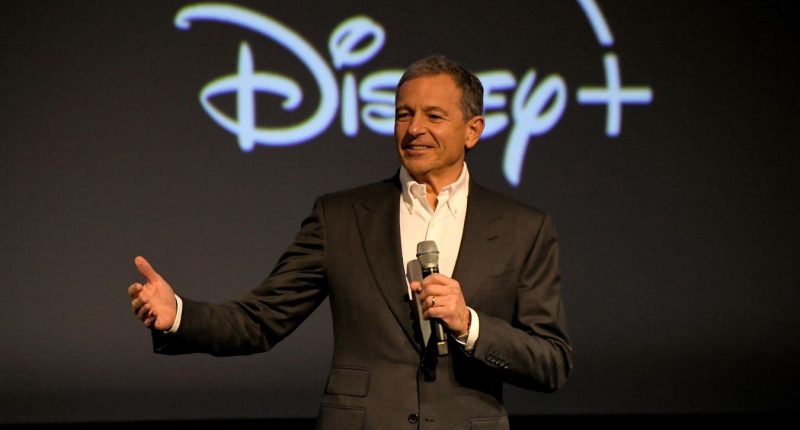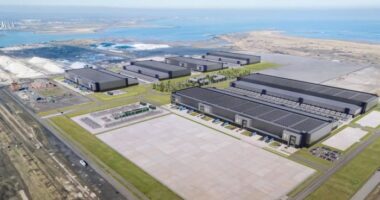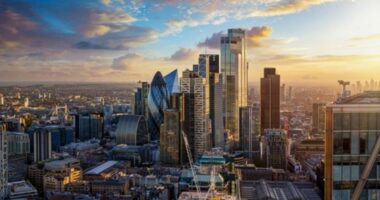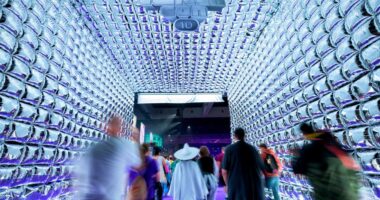Share this @internewscast.com
Bob Iger has time for one more big deal before he exits Disney (Photo by Charley Gallay/Getty Images … More
Getty Images for Disney
Disney’s chief executive Bob Iger built his reputation on doing some of the most momentous deals in the media industry. With only 20 months left on his contract he doesn’t have much time to top them. However, one of the tricks up his sleeve could cast the most powerful spell of them all.
Since Iger first took over Disney’s top job in 2005 his career has been defined by the movie studios it bought. In the space of 13 years from 2006 Iger signed off the acquisition of Pixar, Marvel Entertainment, Lucasfilm and 21st Century Fox causing Disney’s market capitalization to surge more than five-fold to $258 billion. Although it has declined somewhat since then, it is more than three times higher than when Iger took over and there is still room for growth.
Contrary to popular belief, Disney’s business model is driven by theme parks, not movies. Watching them reminds children to ask their parents to take them to the theme parks that are based on them. Gift shops selling merchandise featuring the characters in the rides are cunningly placed at the exits of the attractions so that riders have to pass through them when they are in a carefree frame of mind. This increases the chance that they will buy the merchandise and when their kids see it at home it reminds them of the park. This causes them to pester their parents to book a return visit and the cycle begins anew. It doesn’t come cheap.
Developing a world-class theme park isn’t for the faint hearted. Writing a check for at least a billion Dollars to build it is just the start. Then comes the blockbuster cost of running it.
According to the International Association of Amusement Parks and Attractions (IAAPA), between 55% and 60% of revenue comes from entry tickets with 25% to 30% coming from dining and merchandise and the remainder generated by licensing, sponsorship and special events.
Crucially, the entry tickets tend to be loss leaders meaning that they often don’t cover the parks’ colossal staffing and energy expenses. Total annual running costs for a world-class theme park come close to $1 billion but the loss made on the entry tickets is more than outweighed by the profits made by the on-site shops and restaurants.
Once guests are inside the parks they have little choice but to eat there and the cunning location of the gift shops subliminally tempts them to buy merchandise there.
Shops and restaurants drive Disney’s theme park profits (Photo by Ronaldo Silva/NurPhoto via Getty … More
NurPhoto via Getty Images
Food, beverage and merchandise have low fixed costs and can be sold for a premium as the guests are a captive audience. This gives them the highest margins so the more guests who stream through the turnstiles, the higher the profit for the park operator.
It explains why Disney’s Experiences division, which includes its theme parks, generated just over a third of $91.4 billion revenue last year but nearly 60% of its $15.6 billion operating income.
The more parks Disney operates, the bigger the boost they are likely to give its bottom line. Disney is of course well aware of this which is why Iger told analysts in 2018 that there is “an inevitability” to it building a theme park in a new market although he cautioned that no plans were on the horizon. “We’re going to look,” he added.
His hunt is supported by Disney’s internal research which shows “there is still enormous untapped potential for reaching more consumers.” Specifically, “there is an addressable market of more than 700 million people with high Disney affinity it has yet to reach with its parks. In fact, for every one guest who visits a Disney park, there are more than ten people with Disney affinity who do not visit the parks.”
However, the colossal construction costs make it prohibitive to endlessly increase Disney’s portfolio of parks. Accordingly, it has to choose new locations carefully as Iger explained in a 2018 talk with the Council on Foreign Relations.
“When we make decisions like this, we consider cultural issues, economic issues, and political issues,” he explained. Crucially, the catchment area has to be big enough to support the park without cannibalizing the attendance of one of Disney’s existing outposts. With 14 parks spread across six resorts around the world, you might have thought that Disney had covered all corners of the globe. Think again.
The world is typically divided into three regions – Asia-Pacific (APAC), Europe, the Middle East and Africa (EMEA) and the Americas, which includes North America and Latin America. There are eight Disney parks in the Americas, four in APAC but only two in EMEA. This exposure hasn’t escaped the attention of Disney’s chief rival, Universal Studios, which is owned by media giant Comcast Corp.
Universal currently only has seven theme parks worldwide with four in the Americas, none in EMEA and three in APAC. Although it currently has fewer parks than Disney in every region, it is rapidly expanding.
Universal Studios will open its new Epic Universe park later this month
Universal Studios
On May 22 it will swing open the doors to Epic Universe, its fourth park in Orlando, Florida, which will be followed three months later by an inner-city horror-themed attraction in Las Vegas. Universal is also developing a park aimed at children in Frisco, Texas, as well as a fully-fledged resort in the United Kingdom which is due to open in 2031. It isn’t stopping there.
Last week it came to light that an indoor Universal Studios park could open in 2027 in Delhi, the most populous city in India with 34.7 million inhabitants. If this all goes to plan it would give Universal the same number of parks in the EMEA region as Disney in just six years. In contrast, Disney’s last new park opened in Shanghai back in 2016.
According to a 2023 report in the New York Times, Disney has looked at building a park in India but instead decided to focus on developing new ports for its cruise ships. This reflects comments in the same year from Josh D’Amaro, who heads Disney’s Experiences division.
Talking at a J.P. Morgan conference, D’Amaro dismissed the idea that Disney would follow Universal by building miniparks in the United States, saying that it would instead invest in its major theme parks and cruise ships. “Focusing on our core assets is where we should be spending most of our opportunity,” he said.
In 2023 Disney announced that it would invest $60 billion in its Experiences division over the next decade with half of it spent on the parks and resorts and the remainder on its cruise ships, technology and maintenance. Since then Disney has embarked on its biggest-ever theme park expansion plan with new lands and attractions under development at all of its resorts. So far, no new theme parks have been announced but Disney is adding seven new ships to its fleet giving it a total of 13 by 2031. They are set to make a splash on its bottom line.
As this author revealed in business newspaper City A.M., the latest results for Disney’s cruise subsidiary show that its ships generated $193.6 million of operating income in the year to September 30, 2023. This comes to an average of $38.7 million per ship which is a drop in the ocean compared to a theme park. Testimony to this, in 2023, Disneyland Paris, which is home to two theme parks, made $148.2 million (€140 million) of operating income as this author revealed in The Times.
Disney has recently chosen to focus on expanding its cruise line rather than increasing the number … More
Getty Images
Capacity is the key to these spellbinding returns as theme parks can accommodate far more visitors than even the world’s biggest cruise ships. The latest data from the Themed Entertainment Association shows that the two parks at Disneyland Paris attracted a combined 16.1 million guests in 2023 whereas Disney’s biggest cruise ship can only hold 4,000 people.
After Universal Studios completes its wave of expansion it will have seven sites in the Americas, two in EMEA and three in APAC. Disney will still have more theme parks than its rival in every region with the exception of EMEA where the two will be equal. In order to take back its crown there, Disney will have to build a new attraction in the region.
Disney’s masterplan in Paris commits it to opening a third park by 2036, unless the two existing ones haven’t hit 22 million visitors annually, in which case the deadline will be extended to 2040. By then it wouldn’t be surprising if Universal has given the green light to another park in the region, especially as its president of new ventures, Page Thompson, recently told the BBC that its U.K. theme park will be “just the start of the development”. Hinting at more, he added that “we have a lot more land that we intend to develop…in ways that bring more people to the area and hopefully is beneficial for everybody.”
Disney will have to move fast to stay ahead of its rival in the EMEA region. Africa and India aren’t ideal locations for new parks at the moment as the local market may not yet be wealthy enough to sustain a world-class resort. However, the Middle East could give Disney the magic touch that it needs to stay in the lead and one country in particular has already demonstrated that it would go the distance.
As this report pointed out, unlike the majority of countries, Disney Stores are springing up in the United Arab Emirates (UAE) and in just the past two months flagships have opened in the cities of Dubai and Abu Dhabi. Disney’s highly talented team in the region has broken new ground in retail by bringing Disney Stores bang up to date and promoting the Mouse’s movies in extremely innovative ways as this report revealed. It pays off because, according to Deadline, Disney’s live action remake of Aladdin is the highest-grossing release of all-time across the Middle East. That’s not all.
When The Lion King Broadway production debuted in Abu Dhabi in 2022 it broke the region’s sales record for a stage show with more than 50,000 tickets sold over its four-week run. In just the past six months, Disney on Ice has played in Abu Dhabi along with Disney The Magic Box – a show which mixes music, performers and puppets. Next month Disney Jr Live On Tour: Let’s Play will also come to the city.
There is a tremendous affinity for American brands in the UAE with local branches of retail chains including OshKosh B’gosh, Williams Sonoma, Payless ShoeSource, Bloomingdale’s, Bath & Body Works, Pottery Barn, ACE and The Children’s Place, which once held the Disney Store license. The same goes for restaurants as there are outlets of Applebee’s, Black Tap, Buffalo Wild Wings, Chuck E. Cheese, Dave’s Hot Chicken, Dickey’s Barbecue Pit, IHOP and even Orlando-based casual dining chain Tony Roma’s, once owned by Clint Murchison Jr., founder of the Dallas Cowboys.
Disney is opening new Disney Stores in the United Arab Emirates
MSM
The reason why so many of these chains call the UAE home is that a staggering 88.5% of its 10.2 million residents are expats. Convenience is one of the reasons for this is. Around a third of the world’s population lives within a four-hour flight of the UAE and 96% of the world’s population is within an eight-hour flight. Delhi is just three hours away giving potential guests of Universal’s proposed park a choice of where to vacation. Indeed, more visitors come to Dubai from India than any other country.
Although Disney has not publicly announced that it will plant its flag in the UAE, it clearly isn’t averse to the region. As this report explained, in 2023 it built a 20,000 square meter mini theme park in Saudi Arabia featuring five lands promoting some of its most popular movies. Towering over all of them was a 30 meter-high replica of Cinderella’s Castle which looked just like its counterpart at Walt Disney World in Florida. Tickets ranged in price from $33 (SAR125) to $93 (SAR350) and according to Cundall, the engineering consultancy behind the complex, it was “visited by more than 120,000 people.” It followed discussions at the highest levels.
In 2018 Iger admitted that Saudi Arabia’s Crown Prince Mohammed bin Salman had “made an impassioned plea to me to consider building Disneyland in Saudi Arabia, and I listened with curiosity and somewhat of an open mind.” He added that “I ended up saying that I would visit and see for myself…Whether we grow or not there, I don’t know, but I’ll go.
“There’s a lot of people who live in that part of the world. We have, over time, been asked by many from that region to consider putting a park in that region. And so far, it hasn’t been at the top of our list in terms of markets that we would open up in, but we’ll take a look.”
One discussion followed the announcement in 2003 that Dubai planned to build the world’s largest collection of theme parks. At an estimated cost of $64.3 billion, the Dubailand development was due to cover 107 square miles making it twice the size of Disney World. It was due to include parks from Universal, Paramount, DreamWorks and Marvel. Fueled by Dubai’s profits from oil, the curtain came down on the project during the 2008 economic crisis when property sales slowed and the price of crude crashed by 35% to an average of $60.86 per barrel.
Although Disney wasn’t part of the project it later came to light that there was a plan to attempt to get it on-board. This was revealed in 2014 when the Insights and Sounds website posted a masterplan and concept art of a Dubai Disneyland park produced by Favilli Studios. The agency was founded by Andrea Favilli, a former Disney designer who worked on Disneyland Paris, Disney World and Hong Kong Disneyland.
Favilli Studios was reportedly asked to produce the artwork by Riva Creative which was working on the parks in Dubai. Interestingly, even though the Dubailand development was long gone by the time that the artwork surfaced, Favilli still wanted it to be removed as negotiations were allegedly ongoing. As recently as 2019 Insights and Sounds reported on the project again but the images bit the dust once more.
There is no doubt that the population of the UAE is wealthy enough to sustain a Disney theme park, especially now as it is on a roll.
In 2024 the number of hotel guests across the UAE rose 9.5% to 30.8 million giving average occupancy of 78% across the entire country. Its Gross Domestic Product (GDP) – the value of all of the goods and services it produces – rose 3.9% in 2024 and is forecast to grow by 4.7% in 2025 and by 5.7% in 2026. In contrast, GDP in the U.S. rose by just 2.5% last year and in the first quarter of 2025 it shrank for the first time in three years as businesses braced for President Trump’s tariffs.
The number of hotel guests in the UAE rose by 9.5% in 2024 (Photo by KARIM SAHIB / AFP) (Photo by … More
AFP via Getty Images
According to the UAE’s central bank, the country’s growth is being driven by its non-oil economy which rose 4.6% last year and is expected to increase by 5.1% in 2025. It is part of a strategy by the UAE government which is using the vast resources it amassed from oil to build a leisure infrastructure and diversify its economy due to dwindling fossil fuel reserves.
In April last year Abu Dhabi approved new tourism goals for 2030 as part of this strategy. The city plans to boost visitor numbers to 39.3 million by 2030 in order to increase the amount that travel and tourism contributes to the UAE’s GDP. It is expected to rise from $13.3 billion in 2023 to $24.5 billion in 2030 and theme parks are at the vanguard of this expansion.
The majority of the theme parks in the UAE are government owned and operated as they attract tourists to the country. They are core to the diversification of the economy and the better the parks, the more tourists they attract and the more the strategy succeeds. The government has got practically limitless resources so its strategy has created a portfolio of world-leading theme parks. It’s a magic formula for theme park fans and for the UAE.
No matter where in the world a theme park is located, the traffic to it doesn’t just benefit the operator. Guests often stay in off-site hotels, shop in local stores, eat in local restaurants and visit independent attractions. This keeps local workers in jobs and, crucially, boosts the government’s tax coffers. Reflecting this, data from Disneyland Paris shows that it paid $10 billion (€8.8 billion) in taxes in France between 1992 and 2020 alone.
That’s just the start as a world-class theme park can put a country on the global map and drive tourism elsewhere in it making local and national governments perhaps the biggest beneficiaries even though they typically don’t cover the costs. The park operators, usually movie studios, shoulder that burden and they are usually answerable to shareholders looking for quarterly profit growth. In turn, this leads to frequent increases in ticket prices, perks gradually being phased out and effects in the parks failing to be repaired. It contributes to rising revenue and falling costs which in turn causes an increase in profits. This can have a magic touch on an operator’s bottom line but guests are all the poorer for it.
It isn’t something that visitors to government-owned theme parks have to worry about. The yardstick of success for operators of those parks isn’t purely making a profit but promoting the country they are located in and driving tourism. Governments don’t just benefit from the ticket, merchandise, food and beverage sales but also the incremental increase to the tax receipts from the inflow of tourists.
This is the same model that governments use to justify pouring billions of Dollars into sports events such as the Olympics and it also applies to the billions required to developing a theme park. The government licenses the Intellectual Property, covers the cost of development as well as the operating expenses of the park and retains all of the revenues it generates including the increased taxes.
Disney has not opened a new park since it launched Shanghai Disneyland in 2016 (Photo credit should … More
Future Publishing via Getty Images
This makes it easy to justify the huge investment required to develop a world-class theme park. It explains why Shanghai Disney Resort, which is the Mouse’s most expensive new build at a staggering $5.5 billion, is majority owned by the local government.
Governments have even deeper pockets than movie studios so it’s a magic formula to create the best of the best attractions without any need to cut corners. Cutting corners defeats the object of the theme parks for governments as if guests aren’t happy with the experience, they might not come back to the country. The same goes for failing to fix flourishes in the theme parks and setting ticket prices too high.
With so many government-owned parks in the Middle East, it is perhaps no surprise that IAAPA announced in 2023 that the region was the fastest-growing in the industry, ahead of even North America and APAC. The Middle East arm of RedSeer, a global consultancy specializing in digital sectors, added that the region’s leisure and entertainment industry is expected to be worth $14 billion by 2028.
There is no doubt that the most well-known theme park hub in the Middle East is in Abu Dhabi and there is good reason for this. As this report explained, Abu Dhabi’s theme park operator Miral has developed a world-class collection of indoor theme parks on the man-made Yas Island. It is the world’s most well-connected major resort with multiple world-leading theme parks, a water park, an indoor skydiving wind tunnel, deluxe hotels, a mega mall with 370 shops, an arena, a beach, an F1 racing circuit and a golf course where a round of the PGA European Tour takes place all within walking distance.
Abu Dhabi’s Yas Island is the theme park hub of the Middle East (Photo by Beata Zawrzel/NurPhoto via … More
NurPhoto via Getty Images
Miral is comfortably the world’s leading developer and operator of indoor theme parks but that’s just the start. Several of them are amongst the top five most immersive theme parks worldwide. Indeed, given what Miral has achieved in the harsh climate of the Middle East it may be the industry’s most innovative theme park developer. This is thanks to its visionary chief executive Mohamed Al Zaabi who, in just 15 years, has taken a place in the top five most influential theme park executives alongside D’Amaro, Marc Swanson – CEO of SeaWorld’s parent United Parks & Resorts, Mark Woodbury – Universal’s CEO of Destinations & Experiences, and Peter van Roden, executive vice president of Global Themed Entertainment at Warner Bros. Discovery.
Miral’s parks aren’t just built and designed to the same standards as Disney’s and Universal’s offerings, they are also all game-changers. Miral revved onto the theme park scene in 2010 with Ferrari World Abu Dhabi which features the world’s fastest roller coaster and the only SFX coaster as this report explained. A cross between a simulator and a roller coaster, the SFX is on a par with Universal’s Harry Potter and the Escape from Gringotts, which is widely-considered to be one of the world’s most immersive theme park rides.
Four years after Ferrari World debuted, Yas Waterworld swung open its doors next door. The waterpark is Miral’s only outdoor park and ingeniously mixes rides like 3D theaters and roller coasters with slides in a way which had never been done before. This innovative spirit is shared by Warner Bros. World which opened on Yas Island in 2018.
The park was the product of a partnership which began in 2008 when state-owned Abu Dhabi Media launched a $1 billion fund with Warner for movie and video game development. It led to the creation of Looney Tunes games and the 2009 fantasy film Shorts, starring James Spader. Warner Bros. World evolved from this partnership and broke new ground as just 30% of its floorspace is visible with the remainder being the rides themselves which are hidden behind internal walls. This immerses guests in a fantasy world which is all around them.
You usually know what you’re in for when you head towards a theme park ride as a hulking building looms beyond the entrance. It breaks the fantasy and spoils the surprise. In contrast, at Warner Bros. World the elaborate entrances to many of the rides are set into the internal walls which means that you don’t know what you’re getting until you step inside. It makes the doorways to them seem like portals to different worlds and they are as elaborate as they come. Warner Bros. World uses its indoor setting to the max with scenery which is much more detailed than any outdoor park as there is no danger of it getting damaged by wind, overgrown with foliage or faded in the sun.
SeaWorld opened a state-of-the-art park in Abu Dhabi in 2023
MSM
Two years ago Miral built on this model with SeaWorld Abu Dhabi, the marine park brand’s first indoor outpost and the only one which isn’t home to killer whales. Its U.S. counterparts became infamous for their orcas and attracted anger from activists for this. In contrast, SeaWorld Abu Dhabi has charted a new course by showcasing its conservation work and putting an emphasis on cutting edge attractions as well as elaborate theming.
The scenery outside its attractions is so detailed that it’s akin to the interiors of Disney and Universal rides. As this report revealed, it is also home to a one-of-a-kind simulator inside an LED sphere. Over the next few years Miral is set to work its magic on Harry Potter as a land themed to the boy wizard is also coming to Yas Island.
Following Disney’s model, where the grounds around its parks share the same standards as its parks, Yas Island’s landscaping is immaculate which makes it even more escapist. As a result of all this, Yas Island recorded more than 38 million visits in 2024, 10% more than the previous year. Warner Bros. World also became the first theme park in the Middle East to appear on the Global Attractions Attendance report after 1.8 million visitors streamed through its turnstiles in 2023. SeaWorld could soon eclipse it as the park attracted 1.4 million visitors in its first 12 months alone.
No expense was spared on the island which cost a reported $40 billion to build along with an estimated $1 billion spent on Warner Bros. World and $1.2 billion on SeaWorld.
Warner Bros. World Abu Dhabi is the first theme park in the Middle East to appear on the Global … More
AFP via Getty Images
Disney’s bottom line could get a glow from partnering with a government-owned theme park operator in the Middle East as they would pay a pretty penny to be the exclusive home of one of its parks. Iger alluded to this in 2018 when he said that during his discussion about a Disneyland in Saudi Arabia, Crown Prince Mohammed bin Salman “tried to make the decision easier from an economic perspective”.
By partnering with a local operator in the Middle East, Disney would feel the financial benefit for decades to come. It has a similar arrangement in Japan where Tokyo Disneyland is owned and operated by the Oriental Land Company (OLC), a specialist leisure venue operator listed on Japan’s Nikkei stock exchange.
OLC contracts Disney’s Imagineering design division to develop the attractions and hotels on the 494 acre site and the media giant also earns royalties on revenues generated by the resort. According to filings for other foreign Disney parks “the royalty rate charged by TWDC [The Walt Disney Company] on Disney resorts outside the United States is largely the same at 5% to 10% of revenues, depending on the source of revenues (e.g. merchandise, food and beverage, admission, etc.).”
Disney does not disclose the precise royalty level but according to a 2017 report by market research firm Skift, Disney’s effective royalty rate (based on parks and hotels) averaged at 6.1% over eleven years. In the year to March 31, 2025 that yielded $266 million or 2.9% of Disney’s $9.3 billion Experiences segment operating income.
Based on the Experiences division’s 27.2% percent margin, Disney would need to own a park that made $978 million in revenue in order to generate operating profit equivalent to the royalties from Tokyo Disney. That revenue level is 34.3% more than Hong Kong Disneyland made in 2023. However, unlike owning a theme park, Disney doesn’t have to spend any money on capital expenditure or park operations in Tokyo so the royalties are pure profit.
Doing another deal like that would be a dream ticket for Disney’s stockholders and would see Iger exit on a high. “Do I think he wants to do one more big thing before he leaves? Possibly,” said his advisor Kevin Mayer in an interview last year.
The only time Al Zaabi has ever commented on the possibility of a Disney park in the UAE was in an interview with theme park specialist Stefan Zwanger before the opening of SeaWorld. Replying “next, please”, Al Zaabi laughed off the question: “how did the negotiations with Disney progress on Yas Disney Land?”
Yas Island still has plots of land left which are several times larger than Hong Kong Disneyland though earlier this year at Disney’s Annual General Meeting Iger made it clear that Disney was “mostly focused on expanding in places that we currently operate.”
Nevertheless, if Disney wants to stay ahead of Universal in the EMEA region it may have to expand there. It could even break new ground by exporting to other countries one of the lands from its parks, such as the Star Wars-themed Galaxy’s Edge. That would be quicker to build than an entire theme park and, like Universal’s upcoming Vegas attraction, could be located closer to city centers due to its smaller footprint.
It would be particularly relevant to the UAE as Star Wars: The Force Awakens was partly filmed in Abu Dhabi’s desert. There is also a proven precedent of the local population paying for individual attractions. One of the malls in Dubai is even home to a highly successful coaster with the world’s fastest vertical launch which costs $17.70 for a single ride.
A Disney theme park is one of the few attractions which could drive even more exposure to the UAE even though it is already immensely famous. The country is known for its world-class theme parks, record-breaking buildings and malls, palm-shaped islands and spectacular son et lumière shows. Abu Dhabi is even due to get a version of the Las Vegas Sphere and is reportedly in talks with MGM about building a casino there.
Abu Dhabi is set to get its own version of the Las Vegas Sphere (Photo by Tayfun Coskun/Anadolu … More
Anadolu Agency via Getty Images
However, theme parks even have the power to draw attendance in a way that the world’s biggest sports events can’t dream of doing. Disneyland Paris for example attracts nearly five times more people every year than the previous soccer World Cup in Qatar. And attendance at theme parks doesn’t tail off sharply as it does at the end of a sports event.
The irony is that Disney’s arch-rival Universal was in pole position to capitalize on the UAE market as one of its parks was due to be at the heart of Dubailand. The financial crisis put an end to that and the park hasn’t been resurrected. However, since then Saudi Arabia has begun to emerge as a leisure powerhouse.
Later this year Six Flags Qiddiya is set to swing open on a sprawling site near Saudi Arabia’s capital Riyadh. The park will be home to multiple record-breaking roller coasters including Falcon’s Flight, the tallest, fastest and longest in the world. Next door will be Aquarabia, the largest water theme park in the Middle East. It too features a number of attractions which break new ground including the world’s first Aquaticar underwater theme park ride which sits at the foot of a soaring stone mountain carved into the shape of local animals with water slides weaving through them. Time will tell how the UAE tops it.













